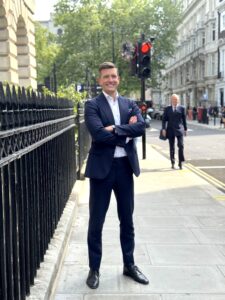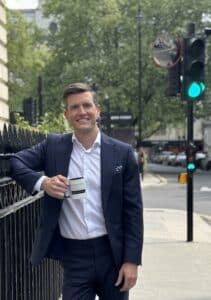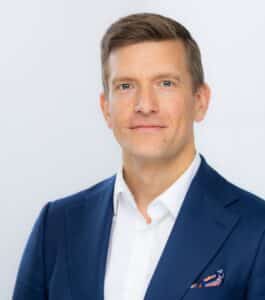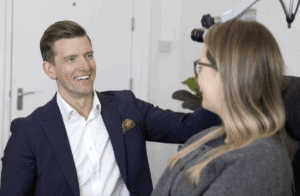MATTHEW ALLSOP – a deep-diving YouTuber helping tech-tangled users get ABOVE THE NOISE
Anyone with the slightest need to search for decent explanations of today’s hearing technology will by now have run into Matthew Allsop, sometimes known as The Hearing Guy, but now more regularly the provider of engaging, to-the-point video content for our friends behind the subscriber-rich HearingTracker channel.
Matthew’s YouTube gig keeps him busy out-of-hours from his day job as an audiologist at London’s Harley Street Hearing practice, of which he is a partner. What started without any towering ambition has relatively quickly found a huge audience, and is growing healthily.

Matthew Allsop skydives over Egypt!
Courtesy of Matthew Allsop
In a profession and sector that has plenty of know-how but undoubtedly needs figures with the panache and projection to bring it more prestige, it is refreshing to find a social media platform inhabited by a star of hearing care. But Matthew Allsop does not get in your face with the overused gestures and phrases typical of most media influencers; his presentation is calm, polished but not flashy, almost old-school British (think 1960s/70s TV), and colloquial without getting cutesy or patronising. His face, posture, diction, accent, and phrasing would not be out of place at the front of a group of RAF Spitfire flyers in a TV dramatisation of the Battle of Britain, a musing lent credibility by Matthew’s frequently changing from earspace to airspace as a qualified skydiver. Wow!
But his video content, and its delivery, are encouragingly free of hackneyed presenter affectations, showbiz acceleration, and commercial corn, whether he is telling us about the hows and whys of tinny-sounding hearing aids, Bluetooth issues, how to turn on subtitles, the specs of hearing glassses, the tinnitus battles of Stereophonics’ drummer Jamie Morrison or, indeed, how to protect your hearing while actually skydiving.
So, what lies behind and ahead of Matthew Allsop’s venture into the media?
Audiology News UK (ANUK): When did you start channeling the video communicator in you? Before you began these hearing aid presentations, had you worked as a communicator, blogger, or even as an actor before?
Matthew Allsop (MA): I remember reading in the intro from one of Jack Katz’s Handbook of Clinical Audiology books’ that “audiology is 50% communication and 50% technical”, and I would argue that, if anything, it leans even more towards communication.
As audiologists we spend our days presenting, educating and communicating complicated information to patients, and trying to break down complex ideas in a simple, human way.
My YouTube journey started with a very simple video for a patient, explaining how to pair their hearing aids to their phone. Once this went online, the views rocketed and I realised that there was a huge opportunity to help more people than those that I could see in clinic. It brings me great joy to know that with around 250,000 views per month on the HearingTracker Youtube Channel; that’s a quarter of a million people that I’m helping over and above those that I’m able to see alone in my practice.
ANUK: You have a busy time as a clinician: how much of your time now goes into producing your videos?

Matthew Allsop: “Another thing that I’m aiming for in the work that I do online: empowering patients to know about the standards and experiences that they should be having when they visit an audiologist.”
Photo: Florence Smith
At this point, all of the work that I do around video production is outside of clinic hours at Harley Street Hearing and Musicians’ Hearing Services. I’m still very much a practising audiologist, seeing patients in clinic every week, alongside an incredible team of highly skilled audiologists and an admin team that keep the practice running seamlessly behind the scenes.
I couldn’t do one without the other. Staying hands-on keeps my content grounded in real-world experience, and I’m able to share the experiences that my patients have (both positive and negative) with those researching hearing aids online. I’m cautious not to let one role overtake the other, as they feed each other, and that’s where the authenticity comes from.
___________________________________________________
“Hearing technology is life-changing, but it’s often shrouded in jargon, marketing noise, and confusion.”
___________________________________________________
ANUK: You dive deep in your reviews and explanations. Please can you explain what the focus is in your videos, what you are providing your audience with, and why you are doing this?
The heart of every video is empowerment. Hearing technology is life-changing, but it’s often shrouded in jargon, marketing noise, and confusion. I want viewers to feel they’ve stepped inside the consulting room with me: to hear an honest, detailed, experience-driven explanation of what a device will and won’t do for them. My focus is always on clarity, trust, and independence. I’m there to serve. I’m not there to sell, and I don’t talk about my practice; the focus is all on the tech on not on me.

Photo: Florence Smith
ANUK: Matthew, you refreshingly claim that in your reviews of hearing devices you are neither funnelling nor amplifying the sales hyperbole from manufacturers, but thoroughly trying out all aspects of products in your clinic, and submitting them to rigorous scrutiny. You even scan forums for user opinions. What feedback, or even pushback, do you get from the industry? What feedback do you get from your audience? And how does that feedback make you feel?
MA: From manufacturers, feedback has been… nuanced. Some respect the honesty and see it as raising the bar for the whole industry. Others, understandably, prefer a more traditional promotional approach, but I believe that long-term trust is worth more than short-term applause. I try to offer a balanced view, and I add my opinion, however there are always facts behind my statements. As I mentioned earlier I‘m not here to serve the manufacturers; I’m here to break down the unnecessarily complicated world of hearing aids for those looking into the best way to take care of their ears.
From the audience, the feedback is overwhelmingly positive, which encourages me to make more content, as it’s doing the job that I would hope. In saying that I would love to encourage more audiologists to start making content around hearing tech, I find it unbelievable that for such a huge industry there are only a handful of content creators out there. Please reach out to me if you’re keen on starting your journey as I would be more than happy to share my experiences, so that you don’t have to make the same mistakes that I have along the way.
__________________________________________________
“I find it unbelievable that for such a huge industry there are only a handful of content creators out there. Please reach out to me if you’re keen on starting your journey.”
________________________________________________
ANUK: Your style is very engaging. From where in your life, and from which cultural fountains, does this polished, enchantingly retro tone and projection come?
MA: I’m flattered by your observations. There is no rulebook for YouTube, or if there is I wish someone had handed it to me three years ago.
When I think about it, I don’t perform for YouTube; the videos are how I would like to think I come across in my appointments. In my opinion, when patients are coming through the door for the first time exploring the world of hearing aids, they can be anxious as they explore the unknown. I hope that I come across in a warm, light-hearted way, using a patient-centred approach. The star of the show isn’t me in clinic, it’s the service that we provide and hearing aid technology that I am recommending. This is the same on YouTube.
ANUK: Do you think your style has a stronger appeal to a domestic UK audience, or are you finding acceptance globally?
MA: Initially, I thought it would be quite UK-specific, but it’s actually found a real resonance globally, with a huge 50% of my audience being based in the US. That’s why you’ll notice that I often discuss prices in dollars or compare things locally to things found in North America. I think there’s a universal appetite for authenticity, especially in healthcare.

Matthew Allsop, jumping with his father.
ANUK: You could have adopted a brasher style, a punching Powerman flashing your teeth at the camera, or perhaps a comforting figure sat by the fireside in a different hand-knitted pullover for each video…but you play with quite a straight bat. Is this because you think that the style fits the profession and industry? Or maybe this is just you?
MA: It’s a bit of both. Audiology deserves the same dignity and professionalism we afford to any other …’ology’. Overly showy or gimmicky presentation would feel wrong. But more importantly, it just wouldn’t feel like me. The straight bat isn’t a strategy, it’s who I am, and if I were to put on a show I would soon run out of steam.
____________________________________________________
“The star of the show isn’t me in clinic, it’s the service that we provide and hearing aid technology that I am recommending. This is the same on YouTube.”
_______________________________________
Biography of Europe’s biggest hearing tech YouTuber: Matthew Allsop
Matthew Allsop is an audiologist, Partner at Harley Street Hearing and Musician’s hearing Services, London, and Content Creator for HearingTracker.

MA
Through his widely acclaimed YouTube channel, he has built a global audience by offering honest, experience-driven reviews of hearing technology, blending clinical expertise with clear, empathetic communication.
A passionate advocate for elevating audiology’s profile, Matthew is committed to making hearing health a mainstream part of the wellness conversation.
He trained at the University of Manchester and has spent his career working with patients from all walks of life, including leading musicians and performing artists.
Outside of audiology, he’s a qualified skydiver, a keen music enthusiast, and an advocate for living life to the fullest, with healthy hearing at the heart of it.
_______________________________________
ANUK: Though you don’t boast of being an influencer, you obviously do influence. What, beyond helping people with hearing loss, do you most want to have a hand in shaping through your videos? Are you in some way setting a standard for how information on hearing devices should be communicated?
MA: I haven’t really thought about why I do what I do in this way before. My biggest goal is to break down the stigma associated with hearing loss, and wearing hearing aids; and make people realise that hearing aids actually give them a superpower. As audiologists we have an incredible gift, which is to provide people with the ability to communicate. However, unless we can raise awareness and get people through the door to start off with, it is all in vain.
I hope to elevate the conversation around hearing health; and shift it from something hidden and reactive, to something aspirational and empowering, like fitness or mental health now are.
If my work can set a higher standard for how we talk about hearing technology, more transparency, more depth, more respect for the audience, then I’ll be proud of that legacy.
ANUK: Let’s talk about how you see your profession. Being a partner at Harley Street Hearing is hardly at the bowery end of a profession that spans a wide spectrum. if you were making videos on cardiology or gynaecology, there would be nothing out of place in well-spoken southerners addressing aspects of their profession on YouTube. Don’t you think audiology needs a higher profile, a touch of charisma?
MA: Absolutely, and I believe it’s long overdue. Hearing health touches every part of a person’s life: their relationships, confidence, career, and overall well-being. Yet for too long, audiology has been seen as a taboo, quiet, almost forgotten corner of healthcare.

Matthew Allsop in his London clinic.
Photo courtesy MA
Being based at Harley Street Hearing and Musicians’ Hearing Services, yes, it’s a premium clinic, gives me a platform to show what audiology can be at its best: clinically rigorous, deeply compassionate, and forward-thinking. However I have to say, that’s how I have always aimed to practise, across my work throughout the NHS, in the nationals, and in my current role.
The spotlight shouldn’t only shine on one end of the spectrum. We need a rising tide that lifts the whole profession: from high street practices to hospitals to independent clinics. We all have the same tools and it pains me to hear some of the experiences that patients have. This is another thing that I’m aiming for in the work that I do online: empowering patients to know about the standards and experiences that they should be having when they visit an audiologist, and if they’re not, then to ask why.
ANUK: How do you see the next decade or so developing in hearing solutions? You’ve highlighted how good some OTC devices are? Is this the future?
MA: We’re at a real inflection point. Over-the-counter devices will democratise access, and in my opinion that’s nothing other than positive. The effect that they’ve had in the US over the last few years has shown that they won’t replace the need for expert, personalised care.
I see the future as layered: with OTC tech options at one end, and premium patient care at the other. Technology will continue to get smarter, but the real breakthrough will be making hearing care part of everyday health, not a hidden, delayed afterthought.
ANUK: A lot of your work focuses on the hearing problems of musicians. What is your own relationship with music? Are you a devotee of any particular genres? Do you play an instrument yourself? How different are hearing needs of people involved in music?
MA: My grade four trombone really isn’t worth boasting about, but music has always been a big part of my life.
As a practice, we focus heavily on hearing protection for musicians, having seen over 23,000 musicians over the last few years with various charity partnerships that we’re involved in.
As you may be aware, from a hearing aid point of view, the hearing needs of musicians are a world apart to the rest of us. It’s not just about hearing loss, it’s about maintaining the thing that they love. Working with musicians pushes us as clinicians to be more precise, more empathetic, and more creative. It’s one of the most rewarding parts of what I do.
ANUK: Are you in this for the long-term? Do you see yourself making these videos when you’re 50, for example (how old are you, by the way?)? Or perhaps there is a pathway to a bigger media platform for you?
MA: Haha. I’m 40 right now, and yes, I’m in this for the long haul. I genuinely love this unchartered space.
If, when I started creating content four years ago, you had told me that I’d be invited to CES, European Parliament, and to visit every manufacturer to meet some of the biggest names in audiology, I wouldn’t have believed you. I have no idea what’s around the corner, but I do know that I love what I do, and I’m excited to see where it goes.
From Audiology News UK issue 14, May-June 2025
 Sign in
Sign in